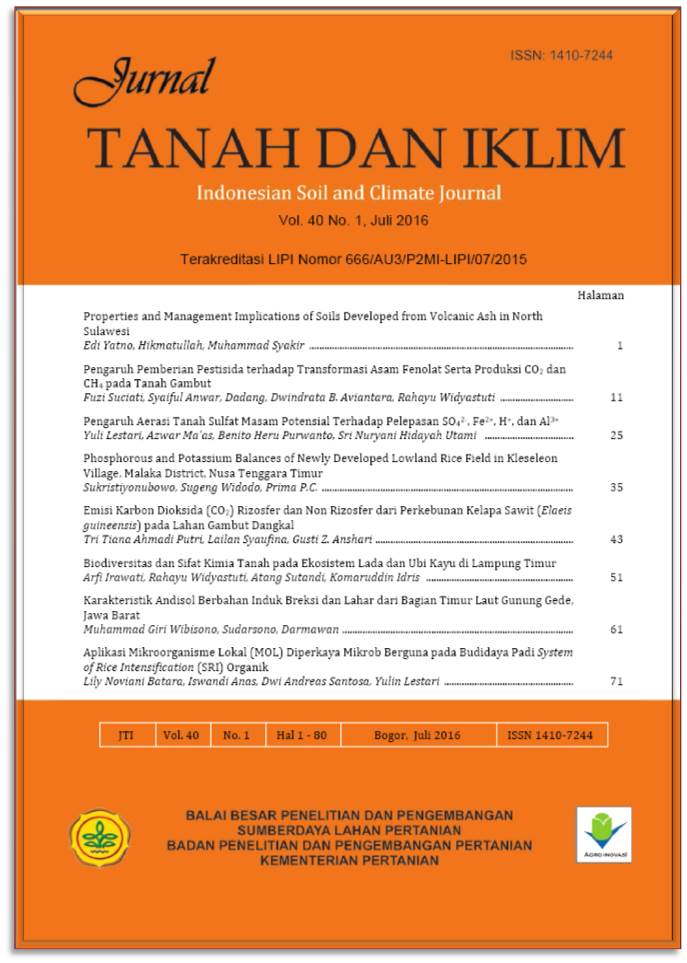Phosphorous and Potassium Balances of Newly Developed Lowland Rice Field in Kleseleon Village, Malaka District, Nusa Tenggara Timur
Keywords:
Nutrient balance, Nutrient input, Nutrient losses, Newly developed lowland rice, Nutrient surplus, Ustifluvent, Neraca hara, Unsur hara yang masuk, Unsur hara yang hilang, Sawah bukaan baru, Surplus haraAbstract
Abstract. Development of newly opened lowland rice fields in Indonesia can be both from up land with ustic to hemic moisture regimes and wetland with quick moisture regime. The study was conducted in Ustifluvent soil type of newly developed lowland rice field in Kleseleon village, Malaka District, Nusa Tenggara Timur Province in 2014. Five treatments were tested including T0: farmers practices, T1: NPK at recommendation rate + Rice straw compost, T2: NPK at recommendation rate + Smart + Rice straw compost, T3: ¾ NPK at recommendation rate + Smart + Rice straw compost and T4: NPK at recommendation rate + Smart + Rice straw compost, in which N, P and K application were split two times. The treatments were arranged in randomized complete block design with three replications. The phosphorous and potassium balances were constructed according to the different between nitrogen inputs and nutrient losses. The aims were (1) to evaluate phosphorous and potassium input – output of newly developed lowland rice field and (2) to validate the phosphorous and potassium recommendation according to the phosphorous and potassium balances. The results indicated that there were surplus P and K across the treatments meaning that the amount of SP-36 and KCl were more than enough to replace P and K removed by harvest product. The recommended P and K should be kept to at least 100 kg SP-36 and 100 kg KCl with added compost at least 3 tons ha-1 season-1.
Abstrak. Pengembangan sawah bukaan baru di Indonesia dapat berasal dari lahan kering dengan kelembaban tanah ustik sampai hemic dan lahan basah dengan kelembaban tanah cepat. Penelitian dilakukan pada tanah ustifluvent dengan kelembaban ustik dari sawah bukaan baru di Dusun Kleseleon, Kabupaten Malaka, Nusa Tenggara Timur pada tahun 2014. Jenis. Lima teknologi diuji sebagai peralukan: T0: Praktek Petani, T1: NPK dengan dosis rekomendasi + Kompos Jerami Padi, T2: NPK denagn dosis rekomendasi + Smart + Kompos Jerami Padi, T3: ¾ NPK dengan dosis rekomendasi + Smart + Kompos Jerami Padi dan T4: NPK dengan dosis rekomendasi + Smart + Kompos Jerami Padi, dimana N, P and K diberikan dua kali. Perlakuan tersebut diatur dengan Rancangan Acak Kelompok yang diulang tiga kali Penelitian bertujuan (1) mengevaluasi unsur hara P dan K yang masuk dan yang keluar pada sawah bukaan baru, (2) memvalidasi rekomendasi pemupukan P dan K berdasarkan keseimbangan haranya. Hasil penelitian memperlihatkan bahwa terjadi surplus P dan K pada pemberian pupuk 100 kg SP-36 and 100 kg KCl ha-1 musim-1, berarti bahwa jumlah SP-36 dan KCl yang diberikan lebih dari cukup untuk menggantikan P dan K yang diangkut oleh hasil panen padi. Rekomendasi pemupukan P dan K sejogyanya dipertahankan paling tidak sebesar 100 kg SP-36 and 100 kg KCl ha-1 musim-1 dengan memberikan pupuk organik dari kompos jerami sebanyak 3 tons ha-1 musim-1.


